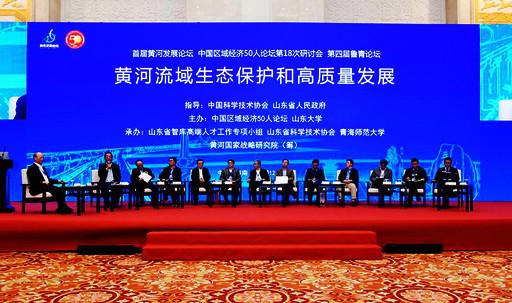
. > WHAT'S NEW > CONFERENCES
Scholars probe high-quality development of Yellow River basin
Author : ZHANG QINGLI Source : Chinese Social Sciences Today 2021-01-04

A forum on the ecological protection and high-quality development of the Yellow River basin in Jinan, Shandong Province on Dec. 13 Photo: SDU
Scholars exchanged views on the ecological protection and high-quality development of the Yellow River basin at a forum in Jinan, Shandong Province on Dec. 13.
After more than 70 years of governance, the Yellow River basin has undergone great changes in its natural landscape, said Zhang Dawei, vice chairman and secretary general of the China Center for International Economic Exchanges. Especially during the 21st century, the implementation of a series of projects has historically improved the basin’s ecological environment, including the construction of Xiaolangdi Reservoir, Xixiayuan Reservoir, and the Three Yellow Rivers (the natural Yellow River, the model Yellow River, and the digital Yellow River), as well as water and sediment regulation, standardized embankment construction, and the relocation of residents in the river’s floodplain.
Promoting the ecological protection and high-quality development of the Yellow River basin is a significant step to fully activate China’s economic resilience, great potential, and maneuvering space. The move is also conducive to promoting coordinated regional development, and building the new development pattern of “dual circulation” that smooths domestic circulation and lets domestic and international circulations reinforce each other, said Liu Yilei, director of the Western China Economic Development and Reform Research Institute at Xinjiang University. Despite rich resources and great potential for development, the Yellow River basin’s regulation faces huge challenges, particularly due to the prominent water shortages and ecological issues. To secure longterm stability within the basin, the water scarcity problem must be solved to ensure the river’s ecological protection and highquality development, said Liu Changming, an Academician of the Chinese Academy of Sciences (CAS) and a research fellow from the Institute of Geographic Sciences and Natural Resources Research at CAS.
The Yellow River requires focused and systematic regulation, and in-depth research on climate change and human activities. Comprehensive studies should be conducted around the river’s Shandong Province section and the estuary delta in order to build a high-quality economic development belt, Liu Changming continued.
Adjusting water consumption structures can facilitate the basin’s ecological protection and high-quality development, said Xiao Jincheng, a research fellow at the Academy of Macroeconomic Research. A water rights trading market should be established based on historical water consumption. Water resource fees should be charged based on water consumption and allocated by the water volume of the river’s cross section. In addition, water rights should be determined according to the population and catchment areas. Adjusting water consumption structures through markets can raise water use efficiency and alleviate the restrictions of water resources on economic development.
Located in north China, the Yellow River basin has relatively low-level development, slow growth rates, low connections within its sub-regions, large differences in regional development, and insufficient innovation and endogenous power, said Wei Houkai, director of the Rural Development Institute at the Chinese Academy of Social Sciences (CASS). Uncoordinated and inadequate development is a prominent problem facing the high-quality development of the basin. To achieve the basin’s comprehensive and coordinated development, community construction is necessary, which means the construction of an ecological community, innovation community, industrial community, and urban community at the basin level, and building an urban-rural development community and rural development community at the regional level.
According to Cao Wenlian, vice president of the China Society of Economic Reform, the ecological protection of the Yellow River basin should be strengthened by adjusting agricultural structures, including the structure of arable land, and developing large-scale eco-agriculture. Meanwhile, the basin’s high-quality development should be advanced under the new development pattern of dual circulation, accelerating the free flow of production factors in the basin.
Governance of the Yellow River basin should uphold the principle of spatial balance, with basin and administrative regions as the units, in an effort to establish and perfect the management and control system of the river’s water resources. In this process, benefit sharing among the people is the ultimate goal of modernizing the basin’s regulation, suggested Chen Xiaodong, a research fellow from the Institute of Industrial Economics at CASS.
During the 14th Five-Year Plan (2021– 2025) period, the Shandong Peninsula should make intensive efforts through two major strategies to build itself into an important strategic node and a supportive zone for the new development pattern, said Yu Donghua, deputy director of the Yellow River National Strategic Research Institute at Shandong University. The first strategy is to fully perform Shandong’s leading role in the ecological protection and high-quality development of the Yellow River basin, forming a large regional development pattern that features North-South balance and East-West synergy. The second is to optimize regional layout. We should highlight the collaborative innovation and development of urban agglomerations, and achieve interconnection and integration between city clusters and their important surrounding areas, thereby attracting a concentration of production factors and enhancing comprehensive competitiveness.
Ye Shengtao made Chinese fairy tales from a wilderness
Ye Shengtao (1894–1988) created the first collection of fairy tales in the history of Chinese children’s literature...
-
How northern ethnicities integrated into Chinese nation
2023-09-18
-
Mogao caves
2023-09-12
-
Mogao Grottoes as ‘a place of pilgrimage’
2023-09-12
-
Time-honored architectural traditions in China
2023-08-29
-
Disentangling the civilizational evolution of China
2023-08-28
-
AI ethics in science fiction
2023-08-23













 2011-2013 by www.cssn.cn. All Rights Reserved
2011-2013 by www.cssn.cn. All Rights Reserved